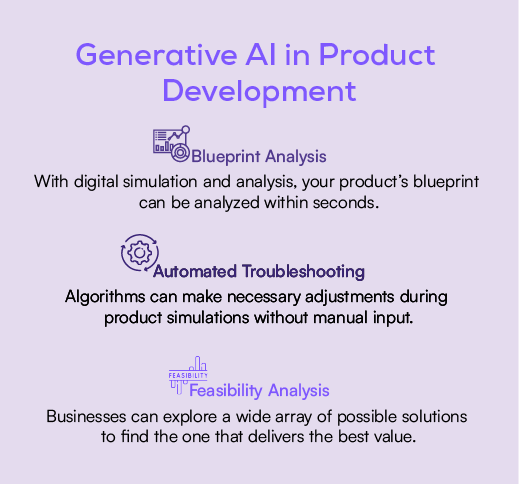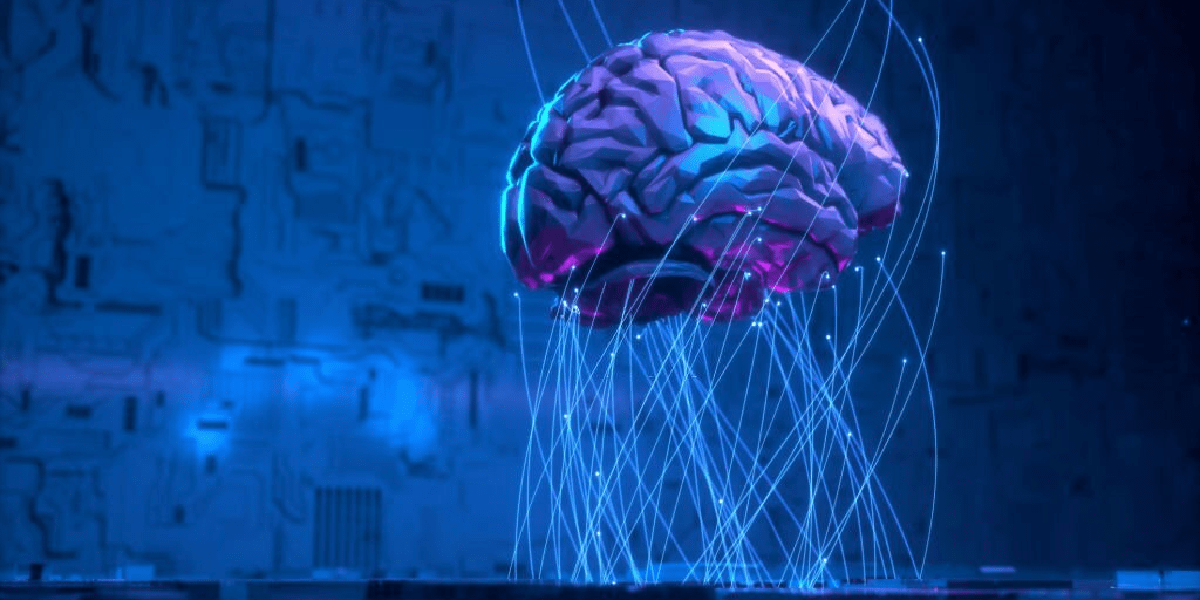Table of content
Are you a product owner or a business analyst?
Then you know that keeping up with the time requires a combination of modern strategies and ground-breaking technology.
It’s no surprise that 60% of businesses are already implementing generative AI to accelerate and enhance every step of their product engineering process. Overnight, transformative AI technology has broadened the scope of opportunities and opened up new avenues for product development.
This post explores how businesses are using generative AI for product development and how it helps them create lasting value.
How Generative AI is Fueling Product Development
Whether you consider improving your time-to-market, making data-driven decisions, or improving overall efficiency, generative AI has got it all covered. Traditional methods of product development were time-consuming and resource-intensive, which meant that businesses had to deal with a higher upfront investment.
Assisting the Development of Market-fit Products
Since the traditional product development approach does not involve a deeper analysis of user feedback, you are unable to develop products according to their needs. As a result, there is a higher risk of developing a product that is not a market fit.
On the other hand, training generative AI for product development allows you to not only accelerate but also improve the accuracy of complex tasks. Instead of relying on guesswork, design teams can leverage user feedback and approach their projects with data-driven insights. Generative AI replaces assumptions with real information, which is why 92% of product managers see a lasting impact of AI on product management.

Broadening the Scope of Product Design
When it comes to product development, time-to-market is key to success. This is where the capabilities of generative AI really shine through. Businesses are using it to develop product ideas by analyzing what competitors are doing and what customers are expecting. Compared to manual brainstorming, the ideation process involving generative AI is much more comprehensive and creative.
For instance, you can create more design variations while staying true to a given criteria. When you feed AI with your design preferences, target audience, and product specifications, it can help you validate your ideas and refine your product. That’s not all - generative AI also helps you achieve digital shelf success by helping you understand the shifting demands of customers.
Finesse - An AI-driven Fashion Retailer
Finesse takes the on-demand fashion trend to the next level with the help of AI. Also known as the first “AI-driven fashion house”, it uses a combination of an AI-based voting system and its proprietary AI algorithms to determine the quantity of each item to be manufactured.

Since the whole process is based on customer demand, it helps the brand in preventing overproduction to optimize costs. In the meantime, the customers can get their hands on the products that they love, and the brand does not have to go through the traditional post-launch user acceptance testing process.
Develop the Products Your Customers Love
Discuss Your Generative AI Project with shopdev Experts
Benefits of Incorporating Generative AI in Product Development
The power of generative AI is not limited to gathering customer feedback and utilizing it for product ideation. It also allows businesses to get the latest insights and base their decisions on market research and trend analysis. Here are some of the benefits of using generative AI for product development:
Enhanced Creativity and Innovation
Normally, product development involves bringing together a group of individuals for brainstorming and ideation. The goal here is to get different perspectives and make room for innovation. But what if we replace the individuals with AI?
With generative AI, you get a significant boost in data processing power, which means you can analyze a wide range of data points related to emerging trends and new product ideas.
AI enhances your team’s creativity by shedding light on areas that you may be ignoring. It factors in data points from different channels, product ratings, focus groups, and social platforms to put you on the right track.
Speeding up Iterations and Prototyping
In the early days, this kind of processing power wasn’t associated with quick results. However, that is not the case anymore. Generative AI analyzes vast amounts of data to identify patterns and delivers the output within seconds. Unlike traditional product prototyping where you need a lot of time and resources, AI-based prototyping essentially automates the whole process.
It speeds up your prototyping process by leveraging machine learning algorithms to create new features and designs. Basically what you are getting is better quality and diversity of ideas in less time than it would take a team of individuals. You can innovate and create differentiated products while reducing operational costs.
Product Personalization
Since every other brand is using personalization to engage customers, you can’t skip this part either. According to a 2022 Salsify research, 70% of U.S. shoppers are more likely to buy an item if there are “personally relevant” images, text, and reviews for it.
Thankfully, you can leverage generative AI to tailor your products to the needs of your customers. As seen in the Finesse example earlier on, you can allow your customers to choose how the product should look like. This agile approach to product design allows your team to try out multiple concepts, curate their ideas, and have better chances of engaging the right audience. Numerous eCommerce businesses are now using the customer-first approach as a way to get positive reviews and make their way to the top.
Cost-efficiency and Resource Optimization
While AI is doing its magic and accelerating your operations, it also helps diagnose problems and eliminate risks. No matter how well you plan your product development process, there are always going to be some hurdles. Generative AI automates repetitive, time-consuming, and resource-intensive tasks to help you save time and manage costs efficiently.
Generative AI can enhance your designs and provide the most suitable options based on manufacturing costs. This involves analysis of the costs associated with materials, assembly, and manufacture. Then, it helps you minimize material waste, optimize the supply chain, and opt for cost-effective options. Generative AI is also capable of suggesting efficient assembly flows and procurement timelines.
Challenges and Considerations
With so many benefits, you might think that generative AI also has some drawbacks. And you’re right. Here are some of the challenges involved in implementing generative AI for product development:
- Complexity of Training Generative AI: In order to implement AI for product engineering, you need specialized knowledge and expertise. Apart from ensuring data security, you need to deal with the complexity of training and maintaining the AI models.
- Ethical Concerns: This is where the difference between humans and machines shines through. Generative AI can raise ethical concerns when it is used to collect and process personal information or intellectual property. The outputs can also be subject to copyright issues and malicious uses.
- Data Quality and Bias: Based on the quality and diversity of the data they are trained with, generative AI models can sometimes deliver biased outputs. As this mainly depends on the datasets used to train the AI, businesses need to be careful about data quality and bias.
- Lack of Control: While the scope of data processing is to be appreciated, you cannot always maintain control of content generated using generative AI. These AI models can even produce undesirable and unexpected outputs that need to be verified and amended manually.
How to Overcome the Challenges of Generative AI
Accuracy
First and foremost, businesses need to ensure that they can train AI models effectively using their own data. This not only allows them to get verifiable outputs but also achieve maximum accuracy. You need to be sure that the generative AI model can identify and process the unique datasets provided by your business and produce the right outputs.
The best way to ensure that your AI models are properly trained is to have a check and balance. Team members should communicate errors and uncertainties in the outputs they get from generative AI. This may also require team members to cite the sources where the generative AI has picked the data, and then explain how it is justified.
Security
While you have assigned tasks to AI experts for training a particular AI model, you need to conduct regular tests to mitigate potential risks. For instance, you need to ensure that there is no bias in the data being used to train the models and whether the outputs being generated contain any harmful content. These security checks also give your business the opportunity to identify vulnerabilities or the involvement of bad actors in the form of potential cyber-attacks.
Transparency
So how do we deal with the issue of bad data quality? By ensuring transparency.
You need to have measures in place to ensure that the data collected to train AI models is evaluated. Your business must respect provenance and have the consent to use the data.
To ensure transparency, your business can use open-source or user-provided data to train AI models. When you are using AI outputs to carry out a task, you need to be transparent and clearly state that the content is generated using AI. Watermarks on the content or in-app messages can be used to differentiate between human-written and AI-generated content.
Future Trends and Implications
AI will Determine Whether or Not a Product is Market-fit
According to statistics, a shocking 35% of SMBs and startups fail because their products are simply not in demand. Soon, AI will help solve this problem. Generative AI-based data analysis will allow businesses to gather accurate data and establish a better understanding of what is required in the market. This includes targeting the right audience and developing the right products within a given category.
AI is already helping businesses understand their customers better with the help of extensive data analysis. It digs deeper into their preferences and searches to find hidden problems in existing products. Up until yesterday, we didn’t have any tools to analyze such information and provide suggestions for product designs and features.
AI will Enhance Human Capabilities for Product Development
Although machine learning has been around for quite some time, the capabilities of AI are now increasing at a drastic rate. While the previously used machine learning algorithm learned patterns and produced outputs using the data provided, the future will see the generation of unseen data. AI will soon be able to apply the ‘learned’ patterns to new and unique data and generate new outputs.
In fact, generative AI models are already advanced enough to take things further. They can not only use unseen data but also develop an understanding of the thought process and ideation behind the datasets provided.
Looking to Redefine Your Product Development Strategy?
Discuss Your Generative AI Project with shopdev Experts
Key Takeaways
From what we have seen in recent times, it is safe to say that generative AI is transforming product development and giving a new angle to innovation. Apart from streamlining processes, improving customer experience, and empowering startups, generative AI is assisting product owners with new design ideas and development processes. As we see the technology evolve, the use cases of generative AI in product engineering and management are set to expand further.




